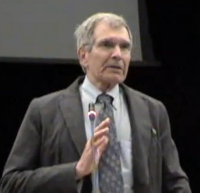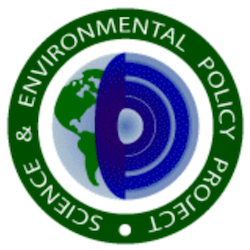VA-SEEE
Background
The Northern Virginia Chapter of Scientists and Engineers for Energy and Environment (VA-SEEE) is a coalition whose goal is to “influence public policy in the areas of energy and environment, and to provide sound information to politicians, the media, and the public in the Commonwealth.”1 “What is SEEE, Really!!”, Northern Virginia Chapter of SEEE, August 27, 2009. WebCite URL: http://www.webcitation.org/6cTXTQzfs
According to the group’s active Facebook page (the only source which appears to discuss the group’s formation), VA-SEEE is a “grassroots organization” founded in 2009 by S. Fred Singer of the Science and Environmental Policy Project (SEPP) “aimed at educating the public on the issues of climate, energy and environment.”2 About – Scientists and Engineers for Energy and Environment-Virginia (Facebook profile). Archived October 22, 2015.
Their goal is to convince policy makers that climate change is not an issue. “Simply put, we need you and every like minded soul the Old Dominion has to offer to get rational words to our policy makers with force and persuasiveness,” they write on their website.3 “What is SEEE, Really!!”, Northern Virginia Chapter of SEEE, August 27, 2009. WebCite URL: http://www.webcitation.org/6cTXTQzfs
While their website, vasee.org, appears to be largely inactive (the last update appears to have been 2010), their Facebook page includes regular posts questioning man-made climate change. VA-SEEE’s mission statement is “To educate the public and policy makers on energy and the environment and to promote rational policy based on the scientific understanding of both.”
In addition to founding member S. Fred Singer, Kenneth Haapala is also associated with the group. Charles Battig is the president of the Piedmont chapter of Scientists and Engineers for Energy and Environment (VA-SEEE).4 “What is SEEE, Really!!”, Northern Virginia Chapter of SEEE, August 27, 2009. WebCite URL: http://www.webcitation.org/6cTXTQzfs
Stance on Climate Change
VA-SEEE released the following white paper (PDF) in 2011:
“The only relevant question to address regarding global warming is whether the miniscule amounts of man made CO2 cause the current global warming. Climate change is always occurring and is caused by natural forces. Man’s contribution to greenhouse gas warming is insignificant and is so small that it is not even measurable. Therefore, trying to change the climate by trying to limit man derived CO2 emissions through any type of public policy is pointless.”5 Martin J. Mangino. “Global Warming, Causation, and Public Policy,” Virginia Scientist and Engineers for Energy and Environment. Archived .pdf on file at DeSmog.
The following excerpt is from an article published by S. Fred Singer in the (New Delhi) Financial Chronicle on Sept 1, 2009 (republished by SEEE):
“Human activities are not influencing the global climate in a perceptible way. Climate will continue to change, as it always has in the past, warming and cooling on different time scales and for different reasons, regardless of any human action. I would also argue that–should it occur–a modest warming would be on the whole beneficial.”6 S. Fred Singer. “Climate Change: Natural and Unstoppable,” Financial Chronicle, September 1, 2009. Republished by the Northern Virginia Chapter of SEEE. WebCite URL: http://www.webcitation.org/6cTXaEVmB
Funding
VA-SEEE does not publicly disclose its funding sources. As it is not a public charity, this information is not freely available for review.
Key People
According to their website:7 “What is SEEE, Really!!”, Northern Virginia Chapter of SEEE, August 27, 2009. WebCite URL: http://www.webcitation.org/6cTXTQzfs
Virginia
- S. Fred Singer
- Randy Randol
- Kenneth Haapala
Northern Virginia
- William Sargent — Chapter President
Piedmont
- Charles Battig — Chapter President
Richmond
- Martin Mangino — Chapter President
Shenandoah
- John Mcnair — Chapter President
Tidewater
- Brett Newman — Chapter President
Actions
July 7–9, 2015
VA-SEE was a co-sponsor of the Heartland Institute’s Tenth International Conference on Climate Change (ICCC10) in Washington, DC.8 “Sponsors,” ICCC10. Archived July 15, 2015.
May 21–23, 2012
VA-SEEE is listed as a co-sponsor of the Heartland Institute‘s Seventh International Conference on Climate Change (ICCC7) in Chicago, Il.9 “Cosponsors,” 7th International Conference on Climate Change. Archived May 10, 2012.
July 24, 2011
VA-SEEE released a white paper on “Global Warming, Causation, and Public Policy.” The summary describes that the goal of the paper is to disprove man-made climate change:
“The purpose of this paper is to demonstrate that climate change or global warming is not causally related to anthropogenic emissions of carbon dioxide (CO2) and, therefore, mitigation of such emissions, as a matter of public policy, is pointless.”10 Martin J. Mangino. “Global Warming, Causation, and Public Policy,” Virginia Scientist and Engineers for Energy and Environment. Archived .pdf on file at DeSmog.
October 22, 2011
Had a joint meeting with the Science and Environmental Policy Project (SEPP) discussing “Climate Change Reconsidered,” the 2011 report of the Nongovernmental International Panel on Climate Change (NIPCC).
The NIPCC is a panel of “experts” funded by the Heartland Institute and coordinated with SEPP to dispute the reports of the official Intergovernmental Panel on Climate Change (IPCC).
Guest speakers at the VA-SEEE / SEPP event included Fred Singer, Kenneth Haapala, and Charles Battig.11 “Heartland Events: Climate Change Reconsidered: A joint meeting update of SEPP and VA-SEEE at VCU,” The Heartland Institute. Archived October 22, 2015. WebCite URL: http://www.webcitation.org/6cTW14Wze
On their Facebook Page, VA-SEEE lists two NIPCC reports as their “products” as the two NIPCC reports.12 About – Scientists and Engineers for Energy and Environment-Virginia (Facebook profile). Archived October 22, 2015.
June 30–July 1, 2011
Scientists and Engineers for Energy and Environment, Northern Virginia Chapter, was a sponsor of the Heartland Institute‘s Sixth International Conference on Climate Change (ICCC6) in Washington, DC.13 “Sixth International Conference on Climate Change” (PDF), the Heartland Institute. Archived July 25, 2015.
DeSmog concluded that 17 of the 43 sponsors of the Heartland Institute’s Sixth International Conference on Climate Change, including the Heartland Institute itself, had collectively received over $46 million from either Scaife Foundations, Koch Foundations, or ExxonMobil.14 Brendan DeMelle. “Denial-a-Palooza 6: Heartland’s Sixth International Conference on Climate Change, Courtesy of Koch, Scaife & Exxon,” DeSmog, June 30, 2011.
March 17, 2011
Charles Battig represented VA-SEEE at a Jefferson Area Tea Party event to discuss the U.N’s “sustainability agenda” and how their policies are “openly dedicated to global government control over every aspect of our lives …”15 “Sustainability Forum on 3/17 in Charlottesville, VA,” Fifth District Watchdog, March 3, 2011. Archived October 22, 2015. WebCite URL: http://www.webcitation.org/6cTZY1VHf
November 18, 2009
SEEE member Kenneth Haapala testified against the EPA, claiming they had “reverted to Medieval science” by ignoring how “The earth’s climate is subject to natural variation.”
According to Haapala, who is not a scientist (his degree is in economics), having more carbon dioxide would be beneficial:
“Carbon dioxide is a necessary food for green plants, thus necessary for life on this planet as we generally recognize it. As discussed in the second report, thousands of experiments and observations show that virtually all food crops and green plants thrive better in an atmosphere enriched in carbon dioxide and better resist stress such as draught, or insect attacks. Contrary to EPA claims, Carbon dioxide enrichment, condemned by these regulations, is a benefit to agriculture, humanity, and the planet.”16 “Ken’s EPA Testimony,” Northern Virginia Chapter of SEEE, November 19, 2009. WebCite URL: http://www.webcitation.org/6cTZcZ96E
November 25, 2009
Martin J. Mangino and Randy Randol of the Richmond Chapter of VA-SEEE sent an open letter to the Science Museum of Virginia disputing a proposed climate change display, claiming it would not be “based on known scientific data regarding climate change.”17 “An Open Letter to the Science Museum of Virginia,” Northern Virginia Chapter of SEEE. September 25, 2009. WebCite URL: http://www.webcitation.org/6cTYeIzSz
Related Organizations
- Science and Environmental Policy Project (SEPP) — Coordinated on NIPCC reports, and share S. Fred Singer as a key member.
Other Resources
Resources
- 1“What is SEEE, Really!!”, Northern Virginia Chapter of SEEE, August 27, 2009. WebCite URL: http://www.webcitation.org/6cTXTQzfs
- 2About – Scientists and Engineers for Energy and Environment-Virginia (Facebook profile). Archived October 22, 2015.
- 3“What is SEEE, Really!!”, Northern Virginia Chapter of SEEE, August 27, 2009. WebCite URL: http://www.webcitation.org/6cTXTQzfs
- 4“What is SEEE, Really!!”, Northern Virginia Chapter of SEEE, August 27, 2009. WebCite URL: http://www.webcitation.org/6cTXTQzfs
- 5Martin J. Mangino. “Global Warming, Causation, and Public Policy,” Virginia Scientist and Engineers for Energy and Environment. Archived .pdf on file at DeSmog.
- 6S. Fred Singer. “Climate Change: Natural and Unstoppable,” Financial Chronicle, September 1, 2009. Republished by the Northern Virginia Chapter of SEEE. WebCite URL: http://www.webcitation.org/6cTXaEVmB
- 7“What is SEEE, Really!!”, Northern Virginia Chapter of SEEE, August 27, 2009. WebCite URL: http://www.webcitation.org/6cTXTQzfs
- 8“Sponsors,” ICCC10. Archived July 15, 2015.
- 9“Cosponsors,” 7th International Conference on Climate Change. Archived May 10, 2012.
- 10Martin J. Mangino. “Global Warming, Causation, and Public Policy,” Virginia Scientist and Engineers for Energy and Environment. Archived .pdf on file at DeSmog.
- 11“Heartland Events: Climate Change Reconsidered: A joint meeting update of SEPP and VA-SEEE at VCU,” The Heartland Institute. Archived October 22, 2015. WebCite URL: http://www.webcitation.org/6cTW14Wze
- 12About – Scientists and Engineers for Energy and Environment-Virginia (Facebook profile). Archived October 22, 2015.
- 13“Sixth International Conference on Climate Change” (PDF), the Heartland Institute. Archived July 25, 2015.
- 14Brendan DeMelle. “Denial-a-Palooza 6: Heartland’s Sixth International Conference on Climate Change, Courtesy of Koch, Scaife & Exxon,” DeSmog, June 30, 2011.
- 15“Sustainability Forum on 3/17 in Charlottesville, VA,” Fifth District Watchdog, March 3, 2011. Archived October 22, 2015. WebCite URL: http://www.webcitation.org/6cTZY1VHf
- 16“Ken’s EPA Testimony,” Northern Virginia Chapter of SEEE, November 19, 2009. WebCite URL: http://www.webcitation.org/6cTZcZ96E
- 17“An Open Letter to the Science Museum of Virginia,” Northern Virginia Chapter of SEEE. September 25, 2009. WebCite URL: http://www.webcitation.org/6cTYeIzSz




